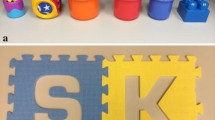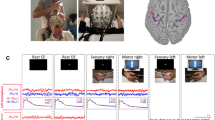Abstract
Recent studies in adults have found consistent contralateral high gamma activities in the sensorimotor cortex during unilateral finger movement. However, no study has reported on this same phenomenon in children. We hypothesized that contralateral high gamma activities also exist in children during unilateral finger movement. Sixty normal children (6–17 years old) were studied with a 275-channel MEG system combined with synthetic aperture magnetometry (SAM). Sixty participants displayed consistently contralateral event-related synchronization (C-ERS) within high gamma band (65–150 Hz) in the primary motor cortices (M1) of both hemispheres. Interestingly, nineteen younger children displayed ipsilateral event-related synchronization (I-ERS) within the high gamma band (65–150 Hz) just during their left finger movement. Both I-ERS and C-ERS were localized in M1. The incidence of I-ERS showed a significant decrease with age. Males had significantly higher odds of having ipsilateral activity compared to females. Noteworthy, high gamma C-ERS appeared consistently, while high gamma I-ERS changed with age. The asymmetrical patterns of neuromagnetic activities in the children’s brain might represent the maturational lateralization and/or specialization of motor function. In conclusion, the present results have demonstrated that contralateral high-gamma neuromagnetic activities are potential biomarkers for the accurate localization of the primary motor cortex in children. In addition, the interesting finding of the ipsilateral high-gamma neuromagnetic activities opens a new window for us to understand the developmental changes of the hemispherical functional lateralization in the motor system.





Similar content being viewed by others
References
Aramaki Y, Honda M, Sadato N (2006) Suppression of the non-dominant motor cortex during bimanual symmetric finger movement: a functional magnetic resonance imaging study. Neuroscience 141:2147–2153
Armatas CA, Summers JJ (2001) The influence of task characteristics on the intermanual asymmetry of motor overflow. J Clin Exp Neuropsychol 23:557–567
Armatas CA, Summers JJ, Bradshaw JL (1994) Mirror movements in normal adult subjects. J Clin Exp Neuropsychol 16:405–413
Armatas CA, Summers JJ, Bradshaw JL (1996) Handedness and performance variability as factors influencing mirror movement occurrence. J Clin Exp Neuropsychol 18:823–835
Cernacek J (1961) Contralateral motor irradiation–cerebral dominance. Its changes in hemiparesis. Arch Neurol 4:165–172
Chen R, Gerloff C, Hallett M, Cohen LG (1997) Involvement of the ipsilateral motor cortex in finger movements of different complexities. Ann Neurol 41:247–254
Cheyne D, Bakhtazad L, Gaetz W (2006) Spatiotemporal mapping of cortical activity accompanying voluntary movements using an event-related beamforming approach. Hum Brain Mapp 27:213–229
Cheyne D, Bells S, Ferrari P, Gaetz W, Bostan AC (2008) Self-paced movements induce high-frequency gamma oscillations in primary motor cortex. Neuroimage 42:332–342
Crone NE, Miglioretti DL, Gordon B, Lesser RP (1998) Functional mapping of human sensorimotor cortex with electrocorticographic spectral analysis. II. Event-related synchronization in the gamma band. Brain 121(Pt 12):2301–2315
Crone NE, Hao L, Hart J Jr, Boatman D, Lesser RP, Irizarry R, Gordon B (2001) Electrocorticographic gamma activity during word production in spoken and sign language. Neurology 57:2045–2053
Crone NE, Sinai A, Korzeniewska A (2006) High-frequency gamma oscillations and human brain mapping with electrocorticography. Prog Brain Res 159:275–295
Dalal SS, Guggisberg AG, Edwards E, Sekihara K, Findlay AM, Canolty RT, Berger MS, Knight RT, Barbaro NM, Kirsch HE, Nagarajan SS (2008) Five-dimensional neuroimaging: localization of the time-frequency dynamics of cortical activity. Neuroimage 40:1686–1700
Davies PL, Rose JD (2000) Motor skills of typically developing adolescents: awkwardness or improvement? Phys Occup Ther Pediatr 20:19–42
Denckla MB (1973) Development of speed in repetitive and successive finger-movements in normal children. Dev Med Child Neurol 15:635–645
Denckla MB (1974) Development of motor co-ordination in normal children. Dev Med Child Neurol 16:729–741
Dorfberger S, di-Japha E, Karni A (2009) Sex differences in motor performance and motor learning in children and adolescents: an increasing male advantage in motor learning and consolidation phase gains. Behav Brain Res 198:165–171
Haaland KY, Harrington DL (1994) Limb-sequencing deficits after left but not right hemisphere damage. Brain Cogn 24:104–122
Hayashi MJ, Saito DN, Aramaki Y, Asai T, Fujibayashi Y, Sadato N (2008) Hemispheric asymmetry of frequency-dependent suppression in the ipsilateral primary motor cortex during finger movement: a functional magnetic resonance imaging study. Cereb Cortex 18:2932–2940
Jurkiewicz MT, Gaetz WC, Bostan AC, Cheyne D (2006) Post-movement beta rebound is generated in motor cortex: evidence from neuromagnetic recordings. Neuroimage 32:1281–1289
Kaiser J, Lutzenberger W (2003) Induced gamma-band activity and human brain function. Neuroscientist 9:475–484
Kaiser J, Lutzenberger W (2005) Human gamma-band activity: a window to cognitive processing. Neuroreport 16:207–211
Kuhtz-Buschbeck JP, Sundholm LK, Eliasson AC, Forssberg H (2000) Quantitative assessment of mirror movements in children and adolescents with hemiplegic cerebral palsy. Dev Med Child Neurol 42:728–736
Largo RH, Fischer JE, Rousson V (2003) Neuromotor development from kindergarten age to adolescence: developmental course and variability. Swiss Med Wkly 133:193–199
Larson JC, Mostofsky SH, Goldberg MC, Cutting LE, Denckla MB, Mahone EM (2007) Effects of gender and age on motor exam in typically developing children. Dev Neuropsychol 32:543–562
Liederman J, Foley LM (1987) A modified finger lift test reveals an asymmetry of motor overflow in adults. J Clin Exp Neuropsychol 9:498–510
Lotze M, Sauseng P, Staudt M (2009) Functional relevance of ipsilateral motor activation in congenital hemiparesis as tested by fMRI-navigated TMS. Exp Neurol 217:440–443
Mayston MJ, Harrison LM, Stephens JA (1999) A neurophysiological study of mirror movements in adults and children. Ann Neurol 45:583–594
McEwen BS (1981) Neural gonadal steroid actions. Science 211:1303–1311
Muller K, Kass-Iliyya F, Reitz M (1997) Ontogeny of ipsilateral corticospinal projections: a developmental study with transcranial magnetic stimulation. Ann Neurol 42:705–711
Nass R (1985) Mirror movement asymmetries in congenital hemiparesis: the inhibition hypothesis revisited. Neurology 35:1059–1062
Oldfield RC (1971) The assessment and analysis of handedness: the Edinburgh inventory. Neuropsychologia 9:97–113
Pfurtscheller G (2003) Induced oscillations in the alpha band: functional meaning. Epilepsia 44(Suppl 12):2–8
Pfurtscheller G, Lopes da Silva FH (1999) Event-related EEG/MEG synchronization and desynchronization: basic principles. Clin Neurophysiol 110:1842–1857
Pfurtscheller G, Graimann B, Huggins JE, Levine SP, Schuh LA (2003) Spatiotemporal patterns of beta desynchronization and gamma synchronization in corticographic data during self-paced movement. Clin Neurophysiol 114:1226–1236
Pfurtscheller G, Neuper C, Brunner C, da Silva FL (2005) Beta rebound after different types of motor imagery in man. Neurosci Lett 378:156–159
Robinson SD, Vrba J (1999) Functional neuroimaging by synthetic aperture magnetometer (SAM). In: Yoshimoto T, Kotani M, Kuriki S (eds) Recent advances in biomagnetism. Tohoku University Press, Sendai, p 302
Ruff RM, Parker SB (1993) Gender- and age-specific changes in motor speed and eye-hand coordination in adults: normative values for the Finger Tapping and Grooved Pegboard Tests. Percept Mot Skills 76:1219–1230
Salmelin R, Hamalainen M, Kajola M, Hari R (1995) Functional segregation of movement-related rhythmic activity in the human brain. Neuroimage 2:237–243
Steinstraeter O, Teismann IK, Wollbrink A, Suntrup S, Stoeckigt K, Dziewas R, Pantev C (2009) Local sphere-based co-registration for SAM group analysis in subjects without individual MRI. Exp Brain Res 193:387–396
Szurhaj W, Bourriez JL, Kahane P, Chauvel P, Mauguiere F, Derambure P (2005) Intracerebral study of gamma rhythm reactivity in the sensorimotor cortex. Eur J Neurosci 21:1223–1235
Uttner I, Kraft E, Nowak DA, Muller F, Philipp J, Zierdt A, Hermsdorfer J (2007) Mirror movements and the role of handedness: isometric grip forces changes. Mot Control 11:16–28
Weeks RA, Honda M, Catalan MJ, Hallett M (2001) Comparison of auditory, somatosensory, and visually instructed and internally generated finger movements: a PET study. Neuroimage 14:219–230
Wilke M, Staudt M, Juenger H, Grodd W, Braun C, Krageloh-Mann I (2009) Somatosensory system in two types of motor reorganization in congenital hemiparesis: topography and function. Hum Brain Mapp 30:776–788
Xiang J, Wilson D, Otsubo H, Ishii R, Chuang S (2001) Neuromagnetic spectral distribution of implicit processing of words. Neuroreport 12:3923–3927
Xiang J, Holowka S, Sharma R, Hunjan A, Otsubo H, Chuang S (2003) Volumetric localization of somatosensory cortex in children using synthetic aperture magnetometry. Pediatr Radiol 33:321–327
Xiang J, Liu Y, Wang Y, Kotecha R, Kirtman EG, Chen Y, Huo X, Fujiwara H, Hemasilpin N, DeGrauw T, Rose D (2009) Neuromagnetic correlates of developmental changes in endogenous high-frequency brain oscillations in children: a wavelet-based beamformer study. Brain Res 1274:28–39
Ziemann U, Hallett M (2001) Hemispheric asymmetry of ipsilateral motor cortex activation during unimanual motor tasks: further evidence for motor dominance. Clin Neurophysiol 112:107–113
Acknowledgements
This study was supported by a Trustee Grant to Dr. Jing Xiang from Cincinnati Children’s Hospital Medical Center, Cincinnati, OH, USA.
Author information
Authors and Affiliations
Corresponding author
Rights and permissions
About this article
Cite this article
Huo, X., Wang, Y., Kotecha, R. et al. High Gamma Oscillations of Sensorimotor Cortex During Unilateral Movement in the Developing Brain: a MEG Study. Brain Topogr 23, 375–384 (2011). https://doi.org/10.1007/s10548-010-0151-0
Received:
Accepted:
Published:
Issue Date:
DOI: https://doi.org/10.1007/s10548-010-0151-0




